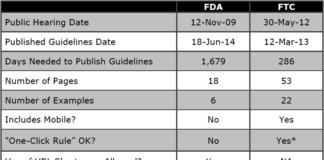Today, Mark Senak (Eye For FDA) posted a podcast interview with Dr. Jean Ah Kang, Special Assistant to Tom Abrams at DDMAC in charge of Web 2.0 policy development (see “A Conversation with FDA/DDMAC About Pharma, Social Media and Web 2.0“).
This was the second time in one week that the FDA had the “bully pulpit” and the ears of ePharma marketers. The first was at CBI’s eMarketing conference in Princeton, NJ, where Sanjay Koyani, Director of FDA Web Communications, gave a keynote presentation, which will be summarized in the March issue of Pharma Marketing News.
On both occasions pharma eMarketers had their ears perked up to hear what the agency had to say about regulation of pharmaceutical marketing on the Web and especially on social networking sites.
On both occasions, we were disappointed.
Regarding the keynote presentation, ePharma Pioneer Club member Jonathan Richman had this to say: “It was the FDA showing all the great things that social media can do (which everyone in attendance knew already), but completely ignored the elephant in the room, which was the question: How can we do it and not get into trouble?”
Mark Senak also was rebuffed in his attempts to get some actionable information out of Dr. Ah Kang. “There was no expectation, of course, that the FDA was going to issue a guidance in the context of a podcast,” said Senak, “but it did seem important to start getting some definition to the environment where there has largely been only speculation.”
Mark posed a scenario to Dr. Ah Kang that I thought was odd. It addressed what Mark said was “the real fear among many companies that if they generate and post original materials that they may later be changed by others.” I’ve never heard that one before and it’s a trivial concern compared to pharma’s fear of adverse reporting obligations.
Dr. Ah Kang spent the last 4-5 minutes going over the details for submission of ALL promotions — including Web ones — produced by pharma for so-called “pre-approval” — actually, “advisory comments” — by the FDA. She said: Go to the FDA website, look over the org chart, find the right division, the right “docket,” the reviewer responsible for the docket, click on the submission information link, and make sure to put together the package as indicated. Be sure to include a cover letter, all your promotional materials, annotate the materials (ie, with “circles and arrows and a paragraph on the back of each one”), include references. highlight and annotate those references (more circles and arrows and paragraphs), include a PI, etc. Got a problem? Call the FDA’s main number!
But whatever you do, don’t leave your name on an envelope in the bottom of that half-ton pile!









![6 Digital Tools at the Center of Healthcare Digitalization [INFOGRAPHIC]](http://ec2-54-175-84-28.compute-1.amazonaws.com/pharma-mkting.com/wp-content/uploads/2021/04/6DigitalTools_600px-100x70.jpg)




